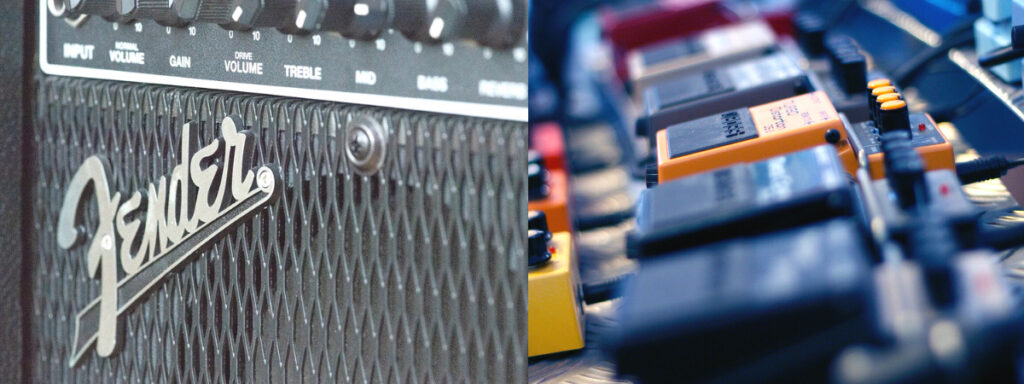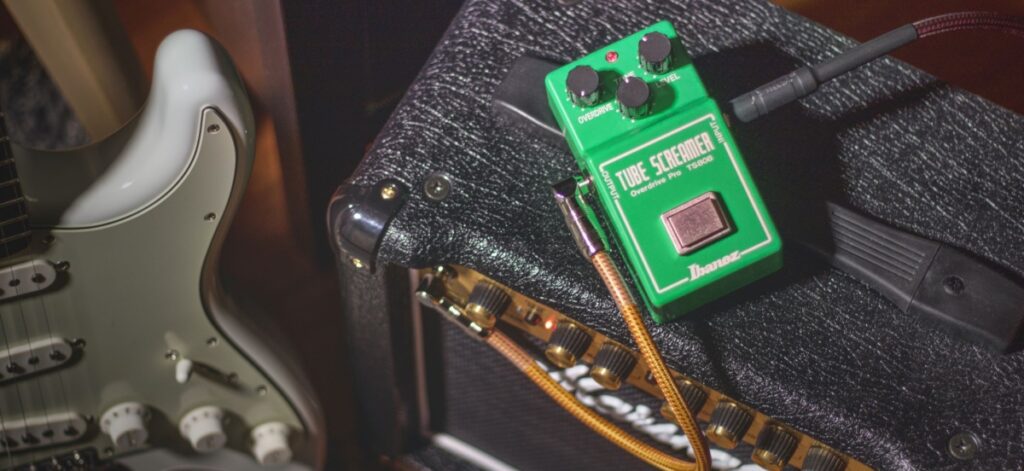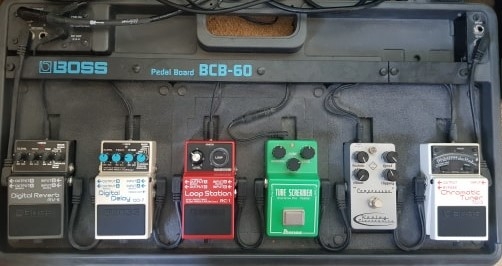If you’re looking to add some different effects to your tone then you can look at effects pedals or use effects built into your amplifier. In this article, I’ll compare these two options so you can decide if you should go with individual stomp boxes (pedals) or an amplifier which is packed with different effects such as the modern modelling amp offerings available today.
The Quick Answer
Effects pedals offer the option to easily switch them on and off mid-song, and are more versatile than the built-in effects in an amplifier. However, built-in amp effects are easier to set-up, save space and work out cheaper than purchasing separate effects pedals.
In this article I’ll be talking more generally about the pros and cons of pedals vs amp effects, but I also have some specific articles on gain and reverb pedals that are also worth checking out if you want to use these effects.

Tone
Before we jump into the “which sounds best” debate, it’s important to make the distinction between solid state and tube (valve amps).
Tube amps are more expensive and produce a more natural and smoother sounding overdriven tone, whereas solid state amps sound more artificial. The benefit of a solid state amp (in addition to the lower price), is that you can usually achieve a wider variety of overdriven/ distorted tones compared to tube amps which create a more specific and limited range of tones.
Tube amps rarely contain many effects except for maybe reverb and of course the ability to add more gain. Solid state amps tend to be packed with more effects, although it will depend on the model.
Some solid state amps are described as “modelling amps” and function using many different modes/ channels to emulate different amp tone. These tend to have more built-in effects.
- When looking at gain-effects e.g. overdrive and distortion, tube amps usually sound the best followed by solid state amps and pedals. However, it is all personal preference and some players will disagree.
- When looking at reverb, tube amps usually come out on top here, followed by pedals and finally solid state amps. Again, it does depend on preference and the exact models in question.
- Since tube amps rarely contain many other effects such as modulation, wah, pitch-shifter etc., we can only really compare solid state amps and effects pedals.
Effects pedals tend to sound better quality than the built-in effects found in many solid state amplifiers. Effects pedals are more fine tuned than amps to create different effects than amps which are a lot more complicated, hence a lot of the attention is focused elsewhere.
There are definite exceptions though. For example, the Boss Katana amp’s built-in effects sound the same as the individual Boss pedals.
Although tone seems like the factor you should be focusing on the most, when it comes to more unique effects it’s usually more helpful to focus on the other factors on this list to help you make your decision.

Versatility
When comparing the versatility of built-in effects on an amp vs individual stomboxes, we can look at four main factors:
- Activation and deactivation
- Number of effects
- Signal chain order
- Controls
Activating and Deactivating
One of the biggest advantages of using individual effects pedals is that they can be turned on and off instantly using just your foot, without having to fiddle with your amp. The obvious benefit here is that you can turn the on and off midway through and song without it affecting your playing.
Some amps allow you to purchase footswitches which let you switch between different presets where you can dial in different tones and effects and switch between them to solve this limitation. However, these often cost between $50-$150 which is a significant investment considering high-quality individual pedals start at around $50.
Number of Effects
As well as considering the amount of effects actually built-into the amplifier as a limiting factor of versatility, you should also consider the number of effects that can be activated at one time. Some amps are set up in a way that allows you to use multiple effects simultaneously without restriction, whereas others use a single control to switch between the different effects, meaning you can’t use more than one at a time.
With pedals, you have complete flexibility here and can use as many pedals as you want to at the same time.
Signal Chain Order
When you use multiple guitar pedals, you can place them in different orders to achieve different effects, since they are cabled together in a continuous chain going from the guitar to the amp. If you’re not sure what I’m talking about here, then check out my guide to ordering effects pedals to learn everything you need to know.
When you use the built-in effects on your amp, you won’t usually be able to control the order they go in, which limits your flexibility.
Controls
With built-in effects on an amplifier, you’ll often get 2-3 different controls. One to select the effect itself, one to adjust the level, and sometimes another to adjust a certain parameter of the effect. For example, with a delay effect you may get an option to adjust the number of repeats, or how long the repeats are spaced apart.
The controls on individual effects pedals are a lot more freeing in most cases. Sure, some pedals keep it simple and use similar controls to those described above, but you can also get some pedals which have all kinds of modes and controls so you can shape the effect exactly how you want to.
Check out my list of the 5 best effects pedals to buy first.

Ease of Use
We’ve just been through a comparison of how versatile pedals are compared to amp effects, but what about the flip side? Some players, and not even necessarily just beginners, prefer to keep things simple and don’t want to spend an age dialling in specific settings. They just want to turn on the amp, flick a few switches and get playing.
Pedal effects are very versatile but this can make them a bit complicated to use for new players. You’ll need to consider the power supply you need, the best order for each pedal, and the individual settings, plus experiment with how these effects interact with your amp. Also if your amp has an effects loop then you’ll need to know which pedals should go here.
It’s not too hard to get your head around, and I’ve written comprehensive guides to walk players through each step in the process, but it can be a bit daunting for total beginners.
Most amps keep things fairly simple and straight forward to operate, and those that don’t will have usual manuals to help as well. You won’t need to worry about the power supply for each pedal and the signal chain order, you can just get started and try the different effects out without additional complications.
If you aren’t put off by the extra complexities of setting pedals up but you’re not really sure where to start, then check out these articles:
- A Beginner’s Guide to the Different Types of Effects Pedals
- Guide to Ordering Effects Pedals in the Signal Chain
- How to Power Guitar Pedals: Power Supplies Explained
Value for Money
If you want to purchase individual effects pedals, or even multi-effects pedals, then you’ll end up spending more than if you were to purchase a modelling amp which comes with tonnes of built-in effects.
Take the Boss Katana amp for example, which contains 15 built-in effects and access to over 60 if you connect it to a PC or app, costs around $240. All these effects are based on the original Boss pedals which cost about $80 each. So if you do the maths here and buying all these pedals would cost $4800.
Keep your perspective though, you won’t need all these pedals, you might only need 3-4, but even then, it pretty much always works out as better value for money if you use the built-in amp effects.
With pedals you also have additional costs including the:
- Power supply
- Patch cables (to connect the pedals to one another if you are using multiple)
- Pedalboard (to keep everything neat)
This can really add up if you’re using multiple pedals.
Space
Built-in amplifier effects don’t take up any extra space, but pedal effects can take up quite a bit of room. Most pedals are around 4-6″ x 2-4″, but some can be a lot larger. Usually, players use a pedalboard to hold them as opposed to having them just lying on the floor.
Pedalboards help to keep everything neat and tidy, but they can get very expensive. I’ve written a full guide to building a pedalboard including all the equipment you need so check it out if you want to go down this route or are wondering how much it’ll end up costing.

Which Should You Choose?
This brings us to the ultimate question, which is the best option?
For beginners or players who want to keep the cost of their rig down, choosing an amplifier with built-in effects is usually a better option than purchasing effects pedals. It works out much cheaper and is easier to set up and get started so you can get an idea of what effects you like.
For more experienced players who are looking for the the best tone, lots of versatility, and are willing to invest more, getting effects pedals is better than using built-in amplifier effects. The additional cost and set-up complications are often less of a concern here.
I use a modelling amp (Blackstar ID Core) for practicing at home and it comes with reverb, delay and modulation effects built-in and they sound great. It helps me keep things simple and keeps the cost down of buying additional pedals. However, I do still have some individual pedals to fill in the gaps where the amp falls short.
Here is a table to summarise the pros and cons of pedals vs amp effects.
| Factor to Consider | Best Option |
| Tone | Effects pedals |
| Versatility | Effects Pedals |
| Ease of Use | Built-In Amp Effects |
| Value for Money | Built-In Amp Effects |
| Saving Space | Built-In Amp Effects |
Here are links to my other articles comparing specific types of effects found on amps and in pedals.
